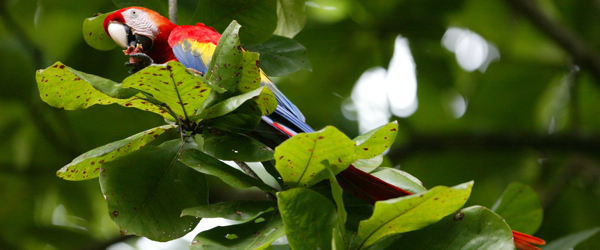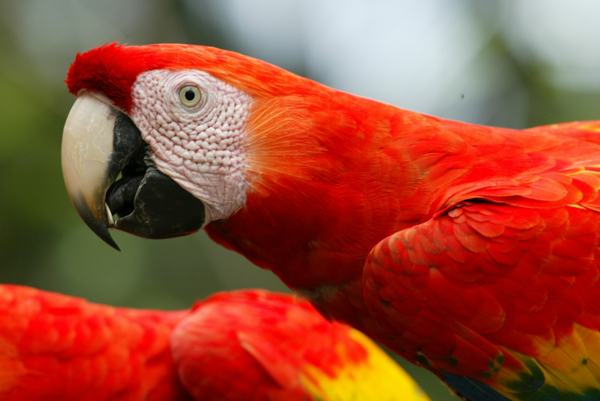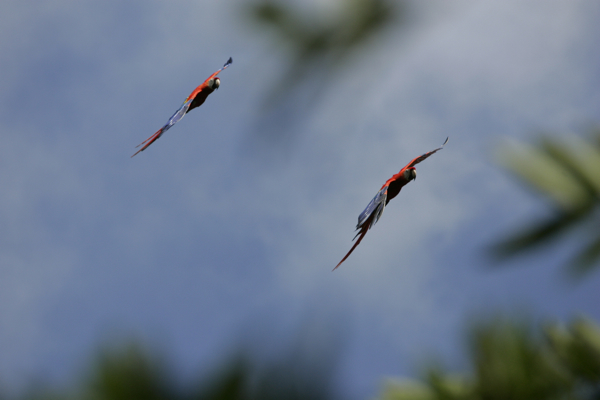Many moons ago, I worked for a conservation organisation based in Costa Rica, called Asociación Amigos de las Aves (The Ara Project) who specialised in the captive breeding, reintroduction and conservation of Central American macaws and parrots.
I spent most of my time and research efforts in the coastal forests of extreme southwestern Costa Rica (Tiskita Jungle Lodge, almost on the border with Panama) and during the almost three years that I spent working with the Scarlet Macaws Ara macao, I was able to develop a method for the unique and reliable identification of every individual in the population (granted, there were only 34 birds). This gave us the chance for all sorts of incredible and unexpected insights, including how the social structure and hierarchy worked.
Essentially, Scarlet Macaws are rather aggressive birds, continually fighting with each other. And they have a well developed sense of personal space. I rarely saw two Scarlet Macaws within about 50cm of each other that were not (a) a pair, or (b) about to get in to a fight. These little squabbles are inevitably initiated by the hierarchically stronger bird and seem to be one of the primary ways of establishing dominance.
At the top of the hierarchy – no surprises here – were the older, breeding age males, with level of aggression appearing to be a primary determinant in sorting it out amongst themselves: i.e. some birds are just more aggressive than others, and always on the look-out for a fight.
Next came the adult females that were paired with very strong adult males. BUT, this only worked if the male was within about 2ft of female, in which case, just his presence elevated her to a “don’t pick a fight with her” status. These females would, interestingly, also often squabble with, and win, against high ranking males, but because of her special status of being paired with and right next to her mate, she seemed to have gummiberry juice. In stark contrast, if her mate was not about, she quickly fell below all males and groups of females. It seems these breeding pair bonds were extremely strong and that the individuals within a pair take little time to culture relationships with other “friends”.
Young females below breeding age, on the other hand, tend to form social tea parties: loose gatherings of birds that “hang out” together. The flocks of young females were somewhat plastic in their composition in that not all birds were always together, with sub-flocks moving off to feed or be somewhere else, but over the course of a few weeks one could inevitable see all of the birds moving, feeding and socialising together. The inter-individual bonds seemed to be weakest amongst the young females; they were less likely to defend each other, and they spent less time in the “personal space” of other macaws. What seemed to happen is that, after the morning feeding in the hotter part of the day, the macaws would rest and preen, but typically somewhat scattered in the tree(s). Every so often, one macaw would approach another to allopreen it. While this almost certainly had a functional value (cleaning hard to reach places), it seemed particularly important in maintaining a “friendship” (for want of a better word). After a minute or two of allopreening, the macaws would either swop, squabble, or quietly move apart to the required minimum of 50cm personal space. Just calmly sitting next to each other for a longer period of time seemed to be rather unusual for these birds.
Now possibly the most fascinating group was the young male macaws. By the time they got to about 4 or 5 years old, they seemed more aggressive than their female counterparts, and more interested in testing their strength and “proving” themselves. It was at this stage that they started to form stronger relationships with another, inevitably male, macaw of about the same age. These bonds were incredibly strong and had I not known for certain that they were both young males, I would have just taken for granted that they were a mated pair, especially as the older male-male pairs often spent time at/near/in/exploring nest cavities. Within these male-male pairs, the individuals were normally very closely matched in strength and aggression (and consequently social ranking as we saw it), unlike the adult male-female pairs in which the female only maintained a high social position when her mate was alongside her.
In the few cases I managed to monitor over a longer period of time, something interested (and expected) happened at some arbitrary (???) point in time when they were between 6 and 8 years old. Suddenly, almost from one day to the next, the two males in the pair stopped spending as much time together during the day (but still roosted together). It only took about 2-3 weeks and the male-male pair had completely dissolved. By the third week, one of the males was normally seen spending more and more time with a female and within a month the whole transition from a male-male to a male-female pair was over.
I found the long road to some smitten of understanding completely fascinating and although I have some feel for how these complex relationships work in a macaw society, it is somewhat difficult to try to translate this in to human terms. “Gay” and “homosexual” have all sorts of subtle social meanings and complexities, depending on who each of us are and how we think. So, maybe the closest analogy would be college roommates/buddies that do everything together, until one of them meets the girl of their dreams….
The End
Check out Corey’s related post Being Gay Good for Birds?
I would like to give my sincerest thanks to Richard and the late Margot Frisius, and all the dedicated staff at The Ara Project for allowing me the time to spend with these incredible birds, and to be a part of such a great on-the-ground conservation project. Thank you.
















You might look at bottlenose dolphins for a comparison. Males in Sarasota Bay are know to form strong, long-term pair bonds. It doesn’t sound the same as with Macaws, but their might be some similar lines of reasoning in the research.
http://www.sarasotadolphin.org/Social/MalePairs.asp
Great post Dale. Exactly the sort of thing that Corey, Mike, and I would never have been able to write on our own 🙂
I really, really enjoyed this post!!!
Very interesting post. What are the genetic relationships between the males? In lions and other cats it are often brothers that operate in this manner.
Macaws as “Bros before hos” fratboys—love it!
@Jason, thanks for the tip. I’ll look in to the bottlenoses, that sounds interesting
Thanks Charlie, there is so much that I saw and documented but never got around to publishing these little bits and pieces. I hope to be able to share some of it here. Better than just dying with my fading memory.
@Christopher, thanks!! I really enjoyed writing it
@City Parrots, siblings often form incredibly strong bonds. Although one bro-bro “pair” were siblings (the two flying in), they were from different clutches so did not grow up together. I believe the power of the sibling relationship is probably related more to growing up together rather than pure genetics.
@Meredith, Fratboys lol. that is about as good as anthropogenic comparisons get. But without the greek letters.
Thank you Dale, for this interesting insight of a species I recently just knew from those pictures and maybe adds. I hope your data will be published somewhere, maybe contributed by further data of other researches. Keep on the good work!
Ha, that was good.
Now, I expect the same quality from your post about the biogeography of birds in South Africa’s forests…
But no pressure, dude, no pressure.
Cheers, and send my regards to the Snowfinches at Kühtai.
@ Jochen, I’ll try. but only if I can take my cutlass with me when sitting at my computer.
@ Martin, what macaw species did you see in Brazil, I never got round to asking you. Gotta see those pics!